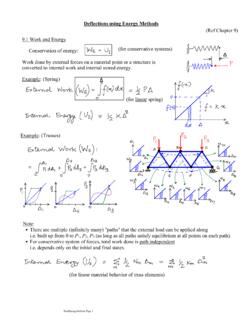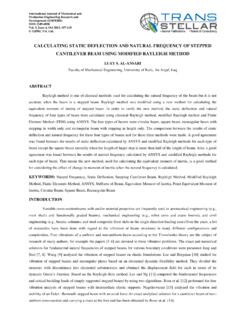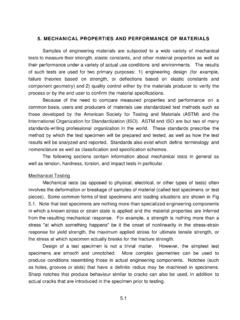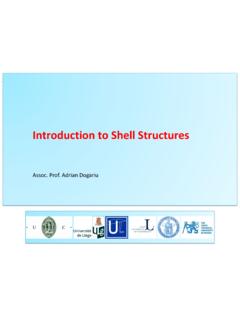Transcription of Chapter 4 - Beam Deflections - Dr. Z. M. Nizam
1 97 Chapter 4 beam Deflections Introduction When a structure is placed under load it will bend, deflect or displace. The deflection will depend on the following factors: 1. Geometry of the structure, including shape and flexural rigidity of member. 2. Flexibility/rigidity of the material used. 3. Restraint of the supports. 4. Load pattern. In the design of structures the primary requirement is to ensure that the structure or structural component can adequately resist the loading to which it is being subjected. This aspect of design is concerned with designing for strength. However there are other aspects of design that are important, and in the case of the design of beams another consideration is the value of the vertical Deflections that will occur when such beam is loaded.
2 This Chapter is intended as an introduction to the analytical techniques used for calculating Deflections in beams and also for calculating the rotations at critical locations along the length of a beam . deflection of Beams The deformation of a beam is usually expressed in terms of its deflection from its original unloaded position. The deflection is measured from the original neutral surface of the beam to the neutral surface of the deformed beam . The After successfully completing this Chapter you should be able to: Develop the general equation for the elastic curve of a deflected beam by using double integration method and area-moment method.
3 State the boundary conditions of a deflected beam Determine the Deflections and slopes of elastic curves of simply supported beams and cantilever beams. This Chapter will discuss various methods to determine the deflection and slope at the specific points in determinate beam . The methods include the Double Integration method and Macaulay method as well as Moment Area method. 98 configuration assumed by the deformed neutral surface is known as the elastic curve of the beam as shown in Figure Figure : Elastic curve Numerous methods are available for the determination of beam Deflections . These methods include: 1. Double Integration Method 2.
4 Moment Area Method 3. Strain Energy Method (Castigliano s Theorem) 4. Conjugate beam Method 5. Method of Superposition Of these methods , the first two are the ones that are commonly used. Therefore, this Chapter will be only focus on the first two methods . Double Integration Method The Double Integration Method, also known as Macaulay s Method is a powerful tool in solving deflection and slope of a beam at any point because we will be able to get the equation of the elastic curve. In calculus, the radius of curvature of a curve y = f(x) is given by The radius of curvature of a beam is given as deflection of beams is so small, such that the slope of the elastic curve dy/dx is very small, and squaring this expression the value becomes practically negligible, hence 99 Thus, EI / M = 1 / y'' If EI is constant, the equation may be written as: where x and y are the coordinates shown in the Figure of the elastic curve of the beam under load, y is the deflection of the beam at any distance x.
5 E is the modulus of elasticity of the beam , I represent the moment of inertia about the neutral axis, and M represents the bending moment at a distance x from the end of the beam . The product EI is called the flexural rigidity of the beam . The first integration y' yields the slope of the elastic curve and the second integration y gives the deflection of the beam at any distance x. The resulting solution must contain two constants of integration since EI y" = M is of second order. These two constants must be evaluated from known conditions concerning the slope deflection at certain points of the beam . For instance, in the case of a simply supported beam with rigid supports, at x = 0 and x = L, the deflection y = 0, and in locating the point of maximum deflection , we simply set the slope of the elastic curve y' to zero.
6 Boundary Conditions Generally, the Deflections is known as y-values and slopes is known as dxdy. The values are called boundary conditions, which normally are: 1. For simply supported beams: (i) At the x-values of the two supports, deflection is zero, y = 0. (ii) If the point ( the x-value) of maximum deflection is known, then at the x-value of the point, the slope is zero, dxdy= 0. 2. For cantilever beams, at the x-value of the built-in end: (i) The deflection is zero, y = 0. (ii) The slope is zero, dxdy= 0. 100 Example Determine the maximum deflection in a simply supported beam of length L carrying a concentrated load P at midspan.
7 Solution: At x = 0, y = 0, therefore, C2 = 0 At x = L, y = 0 Thus, Maximum deflection will occur at x = L (midspan) 101 The negative sign indicates that the deflection is below the undeformed neutral axis. Therefore, Example Find the equation of the elastic curve for the cantilever beam shown in Fig. ; it carries a load that varies from zero at the wall to wo at the free end. Take the origin at the wall. Figure Solution: By ratio and proportion 102 At x = 0, y' = 0, therefore C1 = 0 At x = 0, y = 0, therefore C2 = 0 Therefore, the equation of the elastic curve is Example Compute the value of EI at midspan for the beam loaded as shown in Fig.
8 If E = 10 GPa, what value of I is required to limit the midspan deflection to 1/360 of the span? Figure Solution: 103 At x = 0, y = 0, therefore C2 = 0 At x = 4 m, y = 0 Therefore, At x = 2 m (midspan) Maximum midspan deflection Thus, 104 or Example For the beam loaded as shown in Fig. , determine (a) the deflection and slope under the load P and (b) the maximum deflection between the supports.. Figure Solution: 105 At x = 0, y = 0, therefore C2 = 0 At x = a, y = 0 0 = -[ b / (6a) ] Pa3 + aC1 C1 = (ab/6)P Therefore, Part (a): Slope and deflection under the load P Slope under the load P: (note x = a + b = L) deflection under the load P: (note x = a + b = L) 106 Part (b): Maximum deflection between the supports The maximum deflection between the supports will occur at the point where y' = 0.
9 At y' = 0, x - a do not exist thus, At , 107 Example Determine the value of EIy midway between the supports for the beam loaded as shown in Fig. Figure Solution: At x = 0, y = 0, therefore C2 = 0 At x = 6 m, y = 0 0 = 50(63) - 900(42) - (25/3)(24) + 6C1 108 C1 = 5600/9 N m3 Therefore, At x = 3 m Moment Diagrams by Parts The moment-area method of finding the deflection of a beam will demand the accurate computation of the area of a moment diagram, as well as the moment of such area about any axis. To pave its way, this section will deal on how to draw moment diagrams by parts and to calculate the moment of such diagrams about a specified axis.
10 Basic Principles 1. The bending moment caused by all forces to the left or to the right of any section is equal to the respective algebraic sum of the bending moments at that section caused by each load acting separately. 2. The moment of a load about a specified axis is always defined by the equation of a spandrel where n is the degree of power of x. The graph of the above equation is as shown below 109 and the area and location of centroid are defined as follows. Cantilever Loadings A = area of moment diagram Mx = moment about a section of distance x barred x = location of centoid Degree = degree power of the moment diagram Couple or Moment Load Degree: zero Concentrated Load Degree: first Uniformly Distributed Load Degree: second 110 Uniformly Varying Load Degree: third Example For the beam loaded as shown in Fig.









